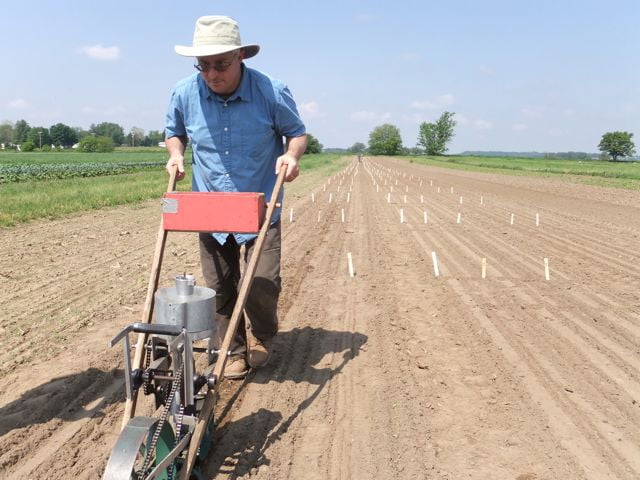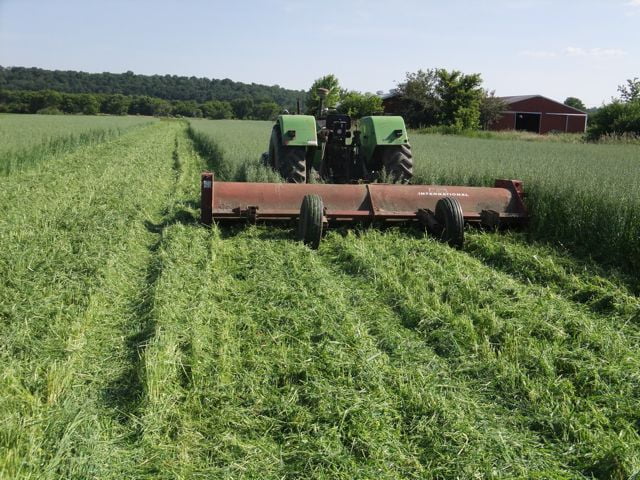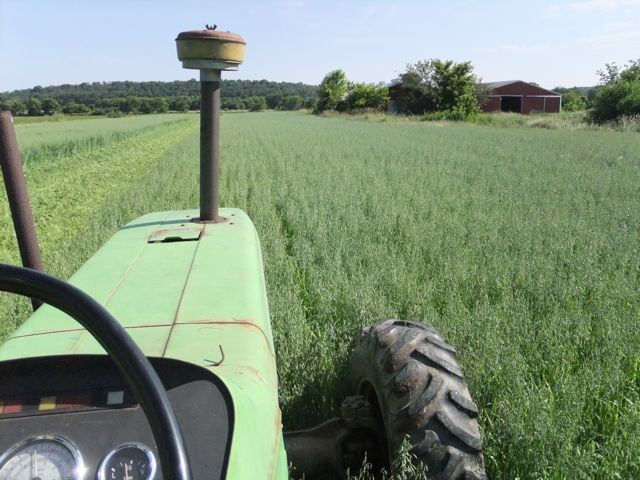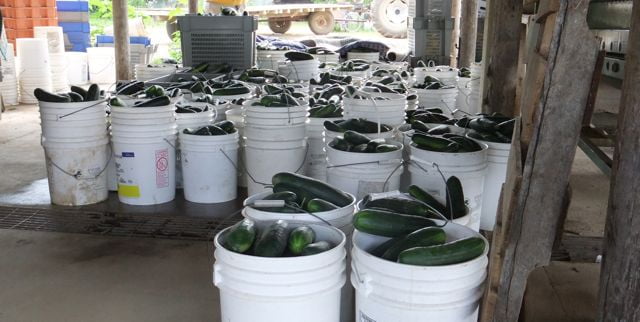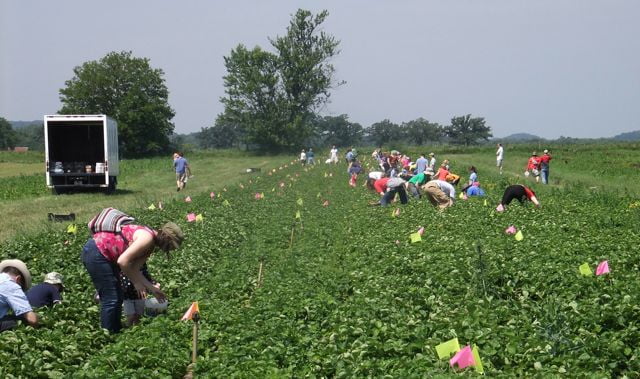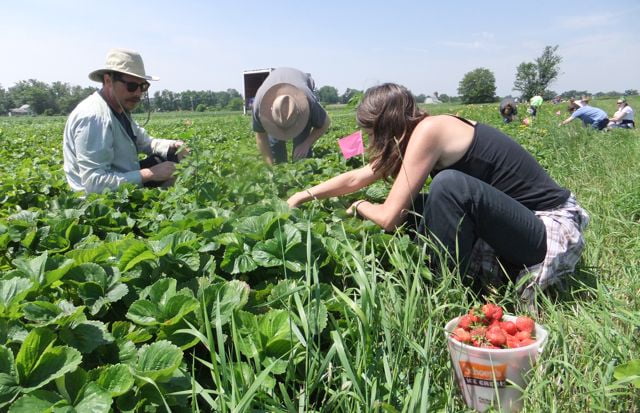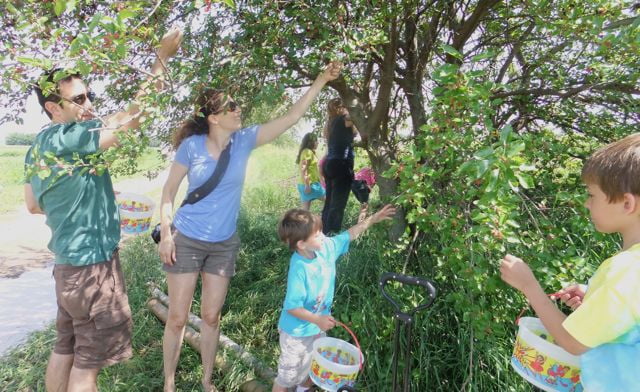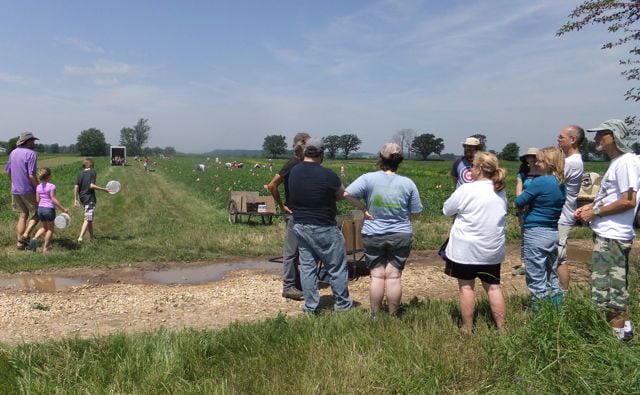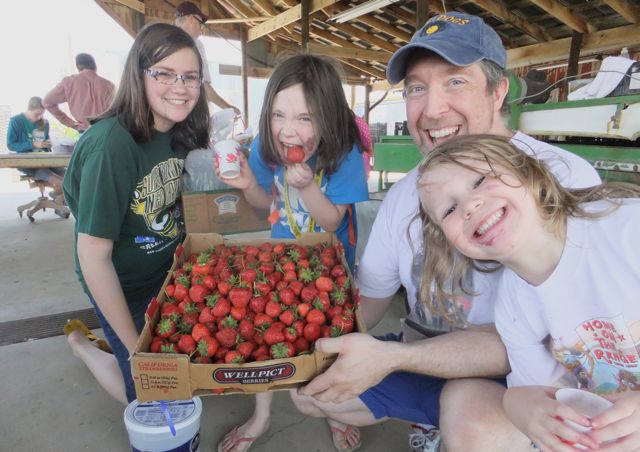Monthly Archives: July 2013
Our hidden beach
- On: July 31, 2013
 0
0
I write often about our farm work, but rarely about the fun of living on a farm. The previous owners of our farm created a sand pit. They sold sand for road construction, leaving an open bowl-shaped pit in a hillside. When we bought our farm, I viewed it as an ugly scar on the landscape and plotted to bulldoze it flat. Wow, I was so wrong. It has become a favorite place for our family. Our children find it endlessly interesting. It was a giant sandbox when they were young, then a terrifyingly steep sled run, now a sheltered and exotic fire pit. For Steve and me, it is a direct look at the glacial till that underlies our farm.
I appreciate the pit on cool fall days. The west-facing slope catches warmth from the setting sun. We picnic there in short-sleeves but would need snow jackets up above. I asked our son what he likes best about the sand pit.
“It’s a good place to find fossils.”
“There’s no dirt – it’s all sand and gravel and there are even different types of sand.”
“It’s a mini desert.”
It is a child’s paradise. We remember the birthday party when a pack of kids soaked themselves under the irrigation, then ran to the sand pit to roll in the warm sand. They looked like sugar doughnuts. This is cheap fun.
Farm News.
• Email brown-out. Remember, I will be away from the farm next week. Please limit communication with us during August 2 through August 12. Contact me no later than 8 a.m. this Friday to cancel a box, ask questions, etc.
• I will deposit post-dated August 1 checks on August 2.
• Carrots. We are working intensively to establish our fall carrot crop. Steve is in the midst of replanting two acres. He planted those fields just before the hot spell and the seeds did not germinate well. This is our last chance to replant. Any later and the carrots will not be ready to harvest before winter sets in. The weeds are growing quickly. Our crew battles them every day. We will be relieved once the new fields are well established. Have you noticed that carrots are missing from the CSA boxes? We often deliver carrots in late July but lost the early planting to weeds during a wet spell in May. Look for carrots from us in about one month.
• The crew’s work is very straightforward right now. It’s all harvesting and weeding. We seeded our last flats of transplants, fall greens like Yukina and mizuna to fill the CSA boxes in November. Those plants will go in the ground in late August, then our greenhouse work is done for the year.
• Spotted wing drosophila (SWD) has appeared in our raspberries again this year. This new fruit fly pest devastated Wisconsin’s fall raspberry crop last year. Once again, it has shown up across the state. Steve has begun weekly applications of organic pesticides. We have recognized the SWD earlier than last year, and are hopeful about limiting the damage. We are optimistic enough that we trellised the brambles this week for easy picking. Our farm is participating in a UW monitoring program to track SWD. Ironically, our children were the first to find the bugs, just like last year. They are observant kids with little fingers, lots of time and a love of raspberries. They spend a lot of time in the berry field.
Veggie List and Veggie Notes
Sweet corn, about 7 ears
Muskmelon, 1
Lacinato OR green kale, 1 bunch
Green bell pepper, 1 or 2
Walla Walla onions, 1 or 2
Zucchini or summer squash, 2 squash
Cucumbers, 2
Slicing tomatoes, about 1 lb
Cherry tomatoes OR eggplant OR green beans
Next week’s box will probably contain watermelon, tomatoes, cabbage, peppers, onions, Romano beans and more.
Sweet corn – Be prepared: some tips will need trimming. Otherwise, this is an excellent, tasty batch of corn.
Email brown-out
- On: July 24, 2013
 0
0
I am taking our children to visit family. We ask that you limit communication with us from August 2 through August 12. Please contact us no later than 9 a.m. on August 2 to ask questions, cancel a box, etc. This is an email brown-out, not black-out. Steve will check my emails but won’t have much time to respond. I’ll be back and ready to communicate on August 13. Thanks for your help with this. Beth
I will deposit August 1 checks on August 2. Many of you paid with checks post-dated to August 1. I will deposit the checks on Friday August 2.
Pat’s recipe featured on NPR.
Our menu chef Pat Mulvey of Local Thyme received an exciting honor this week. Her Ensenada Slaw recipe and the charming story of its discovery were featured on NPR’s “All Things Considered.” Go here to listen to the radio clip and to vote for her recipe. Pat’s recipe is in competition with three other summer recipes featured in short radio segments this week. She’d love the votes and, honestly, it’s the best recipe of the bunch. Keep this dish in mind; we plan to send cabbage again in the next few weeks.
First melons

From left, Noah and Michael toss muskmelons at harvest. It’s the best way to get the melons from the field to the wagon.
We’re glad to have melons to harvest. During the blazing heat last year, the first week we had melons for everyone was July 19. This year, they are ready on July 25. Isn’t that interesting? The weather was so different, but the plants compensated. All our squash-family crops have stayed on schedule despite the cold spring, probably because they were sheltered under row cover. That’s melons, zucchini, cucumbers, pickles, winter squash and pumpkins.
Veggie List and Veggie Notes.
Muskmelon OR watermelon
Green beans, 2 lb
Sweet corn, just 1 ear
Sugar snap peas, 3/4 lb (last of the season)
Cherry tomatoes OR slicing tomatoes
Italian frying peppers, 3
Cucumbers, 3
Pickling cucumbers, a handful
Mixed zucchini and summer squash, about 2 lb
Walla Walla onions, 1 or 2
Basil, 1 or 2 large sprigs
One site will receive globe or Japanese eggplant
Next week’s box will contain sweet corn, melons, green beans, tomatoes, peppers, onions and more.
Sweet corn – We realize that one ear of corn is a tease! Well, they are ready so we are sending them. We suggest you cut the kernels into any cooked dish during the final minutes of cooking. It’s the only fair way to share the one ear. There should be lots of sweet corn next week.
Pickling cucumbers (small cucumbers with thin skins) – These are excellent in salads because of their think skins. Children (at least ours) love them as snacks.
Italian frying peppers (green or red, long, slender) – These sweet frying peppers are special. They contain less moisture than normal bell peppers and therefore can be fried in a small amount of oil, preferably over high heat. They are unbelievably fragrant while cooking. If you attempt to fry normal bell peppers, they release juices and you end up sautéing them instead. Frying peppers are also excellent raw.
Here are several things to watch for on the peppers this week:
– Some peppers have minor sunscald, which appears as a white patch on one side of the pepper. You can eat or cut around this area. Sunscald abates later in the year, as the growing foliage shades the developing peppers.
– Blossum end rot. Many of the Italian peppers have a black tip. This is related to calcium uptake in the plants. Again, just trim off the affected part.
Japanese eggplant (only one site will receive this week) – These eggplant are long, slender, and dark purple. The skin is thinner on this type than on globe eggplant. These are traditionally left unpeeled in Asian cooking, and are often cut diagonally. When cutting lengthwise slices of Japanese eggplant, I find it useful to remove a little skin from the outside slices, as they grill or sauté best when the flesh is exposed.
Subversive carrots
- On: July 18, 2013
 0
0
This season, we are hosting a large carrot variety trial by UW/Horticulture professor Irwin Goldman and graduate student Claire Luby. We try new vegetable varieties each year. Steve evaluates how well the varieties grow, while I judge their sweetness and flavor. This trial, however, involves much more than taste evaluations.
Irwin and Claire have a radical plan. In his years as a vegetable breeder, Irwin has observed an alarming loss of traits that used to be available publicly. As companies patent specific plant traits, they become unavailable for public breeding programs. For example, breeding for red carrots used to be in the public domain. Now that trait has been patented, and breeders are forced to license the patented material or forgo breeding carrots for red color. Red color in carrots is a novelty trait; other patented traits are much more valuable.
In planting this large trial, Claire and Irwin hope to identify unpatented sources of diversity. Their ultimate goal is to develop “open source” breeding lines for release with the stipulation that any varieties developed from their lines must remain unpatented. Irwin is a participant in the Open Source Seed Initiative (OSSI), a group of scientists working to develop open-source seeds for a variety of crops. Irwin told us “The open source model works on the principle that you can receive the seeds if you agree not to tie them up, but you can also use them in breeding, crop production, or even sell them. We hope this will also foster some additional breeding activities by gardeners and farmers who may want to save their own vegetable seeds and do a little breeding on the side.” This recent article (see p. 28) describes OSSI, as well as Irwin, Claire and others’ groundbreaking efforts to breed crops specifically for organic farming systems. These are big ideas that can help farmers everywhere.
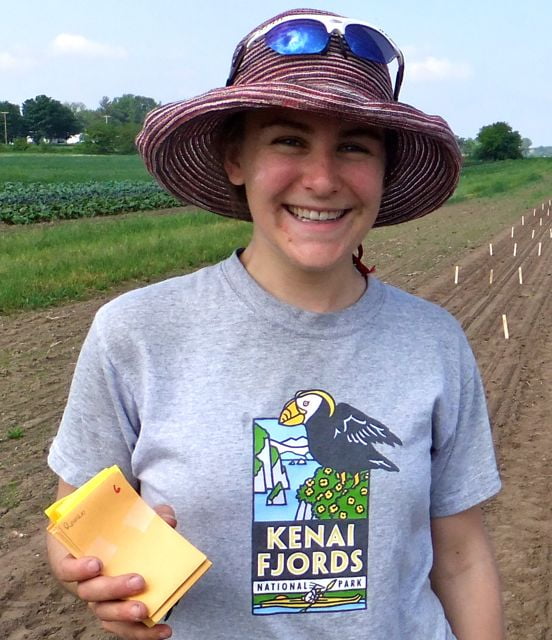
Grad student Claire Luby holds a few of the 150 carrot varieties she cajoled from companies and breeding programs across the USA.
We appreciate the chance to participate in this effort, and the opportunity to evaluate such a wide range of carrot varieties. We almost always host trials when asked by the university. Vegetable farmers lack the financial clout of the corn, soybean or potato industries. Hosting trials is one way we support scientists researching organics or vegetable farming.
Veggie List and Veggie Notes. This week’s veggies show effects from both the recent wet weather and the recent dry weather. Pretty crazy. We’re harvesting during hot weather, so we suggest that you eat your lettuce and broccoli soon. Hot weather at harvest shortens their storage life. If your leafy vegetables seem wilted this week, submerge in a tub of cold water for 15 minutes to help crisp them up. This is a good technique for lettuce, greens, herbs and broccoli.
Cabbage, 3 to 4 lb
Sugar snap peas, 0.8 lb
Lettuce, red leaf or red bibb
Cucumbers, 4 or 5
Mixed zucchini and summer squash, 2 to 2.5 lb
Green OR purple bell pepper, 1
Curly OR flat Italian parsley, 1 bunch
Walla Walla onion, 1
Broccoli (1 head) OR kohlrabi
A few sites will receive 2 Japanese eggplant this week.
Next week’s box will probably contain green beans, cukes, zukes, and more. There might be melons to share too!
Cabbage – This ia a nice salad-type that we grow in summer. It has thinner, more tender leaves than the usual green cabbage. Great in salads and slaws but can also be cooked.
Lettuce – We can still grow lettuce during hot weather as long as we harvest it young. Please ignore the leaf spotting on some heads – it is a remnant of the wet spell that is now fading into distant memory.
Broccoli – Eat soon. Broccoli harvested in hot weather (and stored with ethylene-producing summer crops) does not store well.
Farm news & photos
- On: July 10, 2013
 0
0
The CSA pick-ups went smoothly last week despite the unusual July 4 schedule. Good job, folks!
For us, July 4 means fireworks and carrot planting. Steve begins planting our fall carrot crop on July 3, weather permitting. In a good year, the carrot fields are all planted within two weeks. In a challenging year (like 2012) we replant multiple times to get a good stand of carrot seedlings. Hot dry weather will damage the seedlings despite irrigation. Heavy rains crust the ground and the seedlings can’t emerge. I’ll keep you posted about this year’s plantings.
The time-consuming strawberry harvests are done. Now we are busy harvesting early summer crops like peas and cucumbers, and transplanting winter storage crops such as cabbage. We’re working hard to weed and maintain our summer crops.
Beth
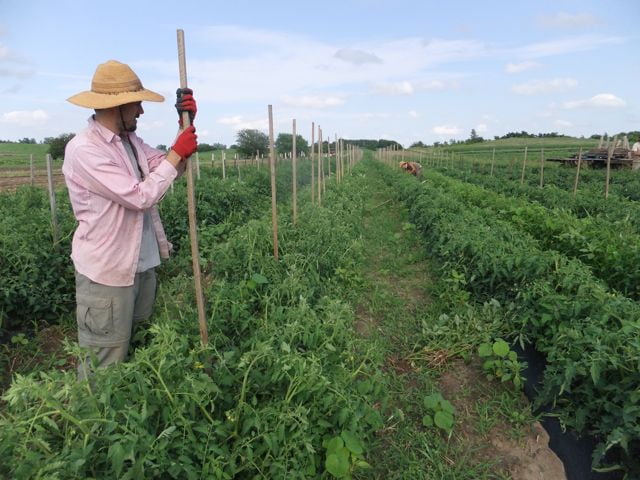
Alex and Boi place stakes in the tomato field. Soon we’ll weave string between the stakes to support the plants.
Veggie List and Veggie Notes.
Strawberries, 1 pint
Romaine lettuce
Walla Walla onion, 1
Broccoli, 1 large or 2 medium heads
Fennel, 1 bulb with luxurious fronds
Cucumbers, 4 or 5
Sugar snap peas, 1.1 lb
Mixed zucchini, patty pan and summer squash, 3 lbs.
Basil, 1 or 2 sprigs
Next week’s box will probably contain cabbage, cucumbers, peas, Walla Walla onion, lettuce & more.
Fennel (large vegetable with a fat bulb and lacy fronds) – Fennel is a ‘swing vegetable’; it can be used raw or cooked. Clean well and slice as thinly as possible for use in raw salads. It is good simply prepared with olive oil, lime or lemon juice, salt and shaved parmesan cheese. Cooking softens and sweetens fennel, and mellows its anise flavor. Both the bulb and leaves are edible. Here are ideas from Alice Water of Chez Panisse about how to use fennel: ‘It’s strong anise characteristic seems to suit fish particularly well. … We use fennel all the time. We add the feathery leaves to marinades for fish and to numerous salads, sauces and soups and we use them as a garnish, too. … The bulbs are sliced and served raw in salads in various combinations with other vegetables, parboiled for pastas; caramelized and served as a side dish; braised whole; or cooked in vegetable broths & fish stocks.”
Walla Walla onions – These are sweet onions, like Vidalias. Wonderful raw or lightly cooked. The crew walked the field to find the biggest onions for today’s box.
Caesar Salad, safely made with cooked egg yolks.
I gave up Caesar salad years ago. Who wants to eat raw eggs? The beautiful Romaine lettuce made me long for Caesar salad, so I researched ways to make it safely. Food scientist Harold McGee has developed a method that works. We add snap peas for crunch instead of croutons. Many Caesar salad recipes call for 10 Tbsp. oil, but you can reduce the oil to 6 Tbsp. and the dressing still works.
Harold McGee’s method to sterilize egg yolks
Use a clean fork at each step to avoid re-contaminating the cooked yolks.
2 large egg yolks
1 & 1/2 tsp. water
1 tsp. lemon juice
Mix the ingredients in a clear glass bowl and beat together with a fork. Cover the bowl and microwave on high power until the mixture bubbles (about 45 seconds). Uncover and stir with a clean fork. Cover and microwave until it bubbles again (about 20 seconds) and let it bubble 5 to 10 seconds more. Stir again with another clean fork. Let cool. The mixture will be custard-like.
Caesar Salad
2 large eggs yolks, cooked as described above and still in the clear glass bowl
2 – 3 Tbsp. lemon juice
1 tsp. Worchestershire sauce
1 clove garlic, grated
2 tsp. anchovy paste
5 Tbsp. olive oil (or less)
5 Tbsp. canola oil (or less)
3/4 cup grated Parmesan cheese
black pepper
1 head Romaine lettuce, cut into 2-inch pieces, washed and carefully dried
croutons and/or snap peas
1. Add the lemon juice, Worchestershire sauce, garlic and anchovy paste to the cooked egg yolks. Stir together with a fork. Let stand 5 – 10 minutes.
2. Slowly drizzle the canola and olive oils into the mixture while beating with a fork to emulsify. Stir in 1/2 cup Parmesan and black pepper to taste.
3. Mix the dressing with the prepared Romaine and croutons (or peas) in a large bowl and toss to coat. Taste and add the remaining 1 Tbsp. lemon juice if needed. Sprinkle remaining Parmesan over top. Serve.
Virtual u-pick tour
- On: July 02, 2013
 0
0
Final reminder: All “Thursday” sites will get their boxes on Wednesday 7/3 due to the July 4th holiday. Friday members are unaffected and will get their boxes on Friday as scheduled.
Here are photos from the u-pick on Sunday, for those who could not attend. The weather was perfect. Steve and I really enjoy the u-picks. It’s a chance to meet members and share the farm.
The berry field.
Strawberry picking was the main attraction.
The mulberry trees are loaded, even on the lower easy-to-reach branches.
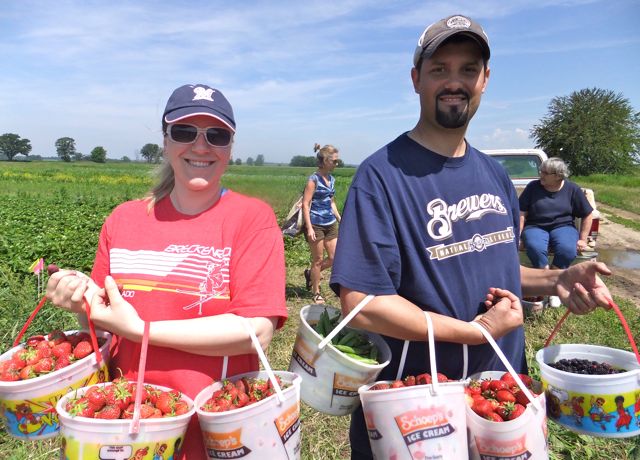
These folks enjoyed all three u-picks: strawberries, shell peas and mulberries.
Steve (in black shirt at center) starts the farm tour while berry picking continues.
There’s a happy family.
Thanks to everyone who let me post their photo here.
Veggie List and Veggie Notes. Local Thyme will have their menus ready early this week.
Strawberries, 1 quart
Sugar snap peas, about 2/3 lb
Snow peas, about 1/2 lb.
The two types of peas are combined in one bag, with snow peas on top.
Napa cabbage, large, about 3 lb
Cucumbers, 2
White salad turnips, 1 bunch
Zucchini/summer squash, 2 to 3 lb
Scallions, 1 bunch
Basil, 1 sprig
Next week’s box will probably contain peas, cucumbers, cabbage, lettuce, strawberries (maybe) and more.
Strawberries – The berries are ripe. Eat them right away.
Napa or Chinese cabbage – This is the large pale green head. This Asian vegetable can be eaten raw in salads, or cooked in simple stir-fries. Napa stores very well. Cut off wedges as needed and keep the rest covered and refrigerated, and it will keep for several weeks. Peel off the outer layer and it will be ready to use. Here are a few preparation ideas from the ‘Asparagus to Zucchini’ cookbook.
– Chop raw napa into green salads.
– Substitute napa in traditional coleslaw.
– Chinese cabbage cooks quickly. Steam 3-5 minutes, or until leaves are wilted down but remain slightly crisp.
– Substitute napa cabbage for common cabbage in recipes, but reduce the cooking time by 2 minutes.
– Napa cabbage is the main ingredient in egg rolls. Try making an egg roll mixture to eat as a cooked side dish instead of preparing time-consuming egg rolls.
Snow peas (flat pea pods) – These are excellent stir fried or in raw salads. The thicker pea pods will usually have two strings along the edges. Remove them when you snap the stem off.
Scallions – These green onions are large but remain quite tender. Use raw or for cooking.
Basil (stem with frilly green leaves) – This is the variety ‘Napoletano.’ The leaves are larger and more frilly than most basils. We like this variety because the its leaves remain tender and flavorful even as the plants mature. Basil will blacken if stored in the refrigerator. It is best stored at room temperature, with the cut ends in water, for example in a glass or teacup. You will receive one or two sturdy stems this week. This are from the first pruning to shape the plants.




